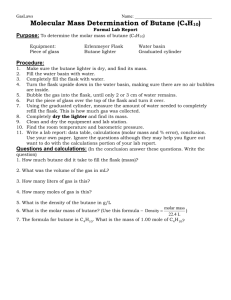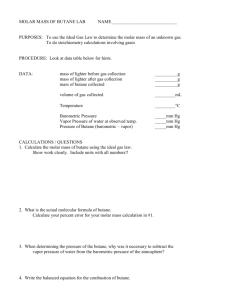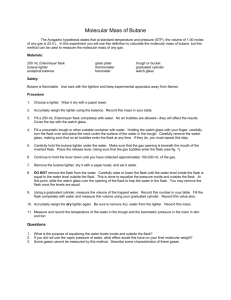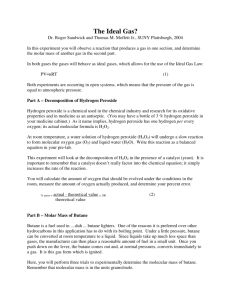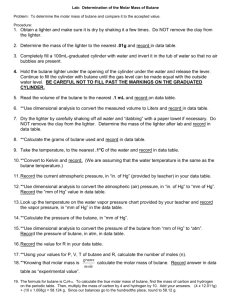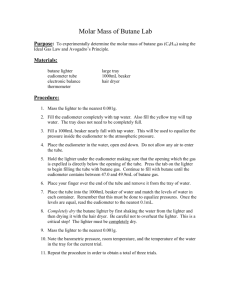DETERMINATION of the MOLAR MASS of BUTANE
advertisement
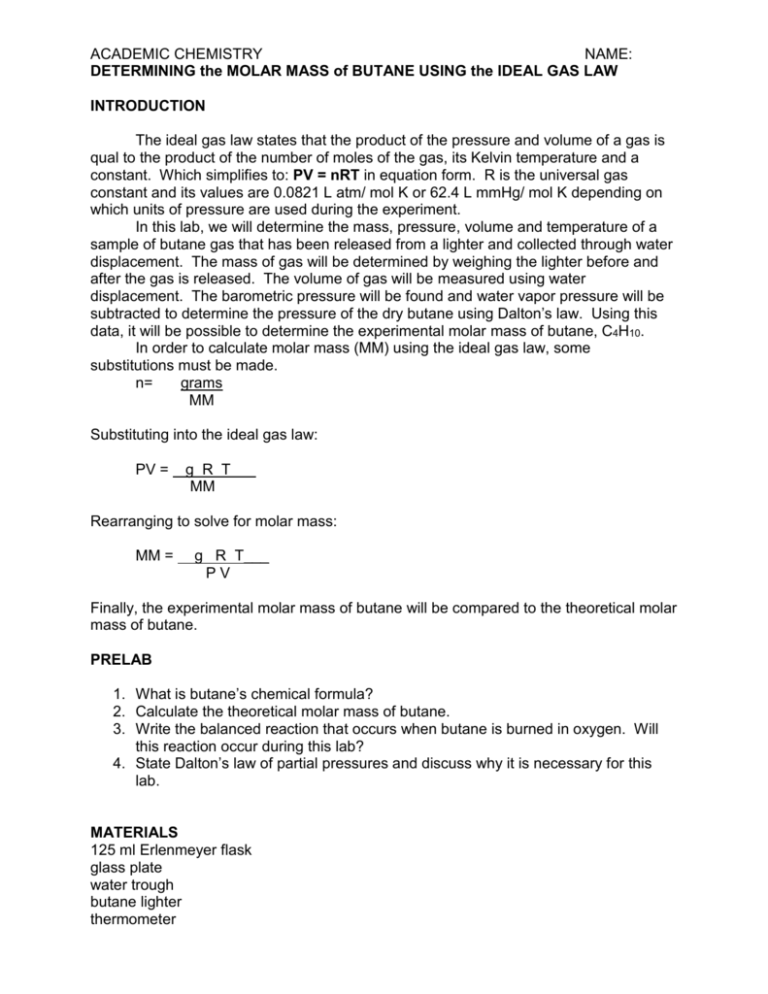
ACADEMIC CHEMISTRY NAME: DETERMINING the MOLAR MASS of BUTANE USING the IDEAL GAS LAW INTRODUCTION The ideal gas law states that the product of the pressure and volume of a gas is qual to the product of the number of moles of the gas, its Kelvin temperature and a constant. Which simplifies to: PV = nRT in equation form. R is the universal gas constant and its values are 0.0821 L atm/ mol K or 62.4 L mmHg/ mol K depending on which units of pressure are used during the experiment. In this lab, we will determine the mass, pressure, volume and temperature of a sample of butane gas that has been released from a lighter and collected through water displacement. The mass of gas will be determined by weighing the lighter before and after the gas is released. The volume of gas will be measured using water displacement. The barometric pressure will be found and water vapor pressure will be subtracted to determine the pressure of the dry butane using Dalton’s law. Using this data, it will be possible to determine the experimental molar mass of butane, C4H10. In order to calculate molar mass (MM) using the ideal gas law, some substitutions must be made. n= grams MM Substituting into the ideal gas law: PV = g R T___ MM Rearranging to solve for molar mass: MM = g R T___ PV Finally, the experimental molar mass of butane will be compared to the theoretical molar mass of butane. PRELAB 1. What is butane’s chemical formula? 2. Calculate the theoretical molar mass of butane. 3. Write the balanced reaction that occurs when butane is burned in oxygen. Will this reaction occur during this lab? 4. State Dalton’s law of partial pressures and discuss why it is necessary for this lab. MATERIALS 125 ml Erlenmeyer flask glass plate water trough butane lighter thermometer ACADEMIC CHEMISTRY 100 ml graduated cylinder wax pencil PROCEDURE NAME: Collecting the butane: 1. Fill an Erlenmeyer flask completely full and cover the mouth of the flask with a glass plate, making sure that no air gets trapped in the flask. 2. Fill a trough about ¾ full of water. Hold the plate in place and quickly invert the flask into the water trough. If air bubble result, you must repeat this procedure. 3. Obtain a lighter and wipe it clean with a paper towel. Blow out any water the may be trapped in the striker mechanism from a previous experiment. If the lighter is adjustable, make sure the flame adjustment is set to give the largest flame. 4. Place the clean, dry lighter on a balance and determine its weight to the nearest hundredth of a gram. Record this value in your data table. 5. Carefully hold the butane lighter underneath the Erlenmeyer flask. Make sure that the gas opening of the lighter is beneath the mouth of the flask. Press the release lever, being sure that the gas bubbles enter the flask. 6. Continue to hold the lever down until you have collected about 120 ml of gas. 7. Remove the butane lighter and let it dry completely on a paper towel. 8. Carefully raise or lower the Erlenmeyer flask until the water level inside the flask is at the same point as the water level outside the flask. This it to make sure that the total pressure inside the flask = atmospheric pressure (outside the flask). Mark the gas/ water level using a wax pencil or a sharpie. 9. Remove the flask from the trough and fill it with water to the mark. Measure the volume of the water using a graduated cylinder. This is really the volume of the gas that was collected. 10. Thoroughly dry the lighter with a paper towel, weigh it, and record its mass in the data table. 11. Measure the water temperature and record it. 12. Record the barometric pressure in the room in your table. POST LAB QUESTIONS 1. Calculate the molar mass of an unknown gas if 975 ml of it at 19C and 0.962 atm weighs 7.29g. 2. A tank of compressed air has a total pressure of 8547 mmHg. If the partial pressure of the nitrogen is 6,752 mmHg, and the partial pressure of the carbon dioxide is 9 mmHg, what is the partial pressure of the oxygen? ACADEMIC CHEMISTRY NAME: 3. Discuss how the following errors would affect your overall molar mass calculation: a. The lighter still contained water when you weighed it the second time? b. Some gas escaped into the water trough instead of entering the flask? c. The vapor pressure of water was not accounted for? DATA Initial mass of lighter Final mass of lighter Mass of butane collected Volume of the butane collected (volume of water in the Erlenmeyer flask) Liters of butane collected Temperature of the water Kelvin temperature of the water (and gas) Pressure of water vapor at that temperature (see text book appendix or Dalton’s law notes) Barometric pressure Pressure of the “dry” butane gas Experimental molar mass of butane Theoretical molar mass of butane % error CALCULATIONS 1. calculate the mass of butane collected 2. calculate the Kelvin temperature 3. calculate the pressure of the dry gas using Dalton’s law ACADEMIC CHEMISTRY 4. molar mass calculation using ideal gas law 5. % error calculation NAME:
